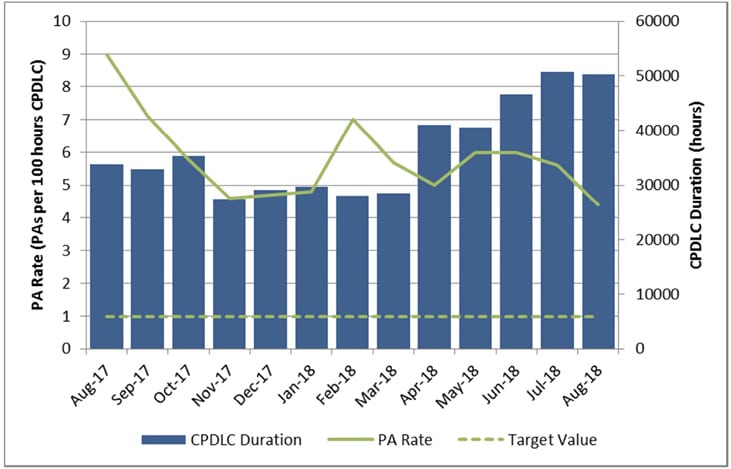
Provider Abort rate for European DLS ground stations. Image courtesy of SESAR DM
In August, the number of times aircraft flying in European airspace lost connectivity with data-link ground stations dropped to the lowest number since the stations were first implemented.
Data reported by the Single European Sky ATM Research Deployment Manager (SESAR DM) showed the number of provider aborts (PAs) had reached a rate of 4.4 per 100 flight hours for the month of August. A provider abort is the loss of data link availability for an individual aircraft. PAs occur when there is a lack of air-to-ground connectivity for more than six minutes, leading to a service loss, according to SESAR DM.
The performance of the ground stations in August is a major improvement on the DLS program compared to 2015, when the European Commission was forced to delay the European airspace CPDLC mandate from February 2015 to February 2020. European officials were forced to delay the mandate because aircraft were experiencing too many PAs.
Commission Implementing Regulation (EU) 2015/310 requires legacy aircraft flying above 28,500 feet (FL 285) to be equipped with Future Aircraft Navigation System (FANS) 1/A or a router, antenna, CPDLC messaging interface and device, alerting system and a VHF Data Link (VDL) Mode 2 radio by Feb. 5, 2020. Some of the most common messages communicated between aircraft and the ground stations are air traffic controller (ATC) communications management service (ACM) and ATC clearances and information services.
SESAR DM’s goal is for Europe’s 200 DLS stations to achieve a one-PA-per-100-hours-CPDLC rate by 2020. The DLS stations are operated by each individual European air navigation service provider (ANSP). The group performs a regular monitoring exercise on DLS performance status using input and feedback from airspace users and ANSPs.
Eurocontrol’s Network Manager (NM) has been tasked with keeping track of the performance of the stations under a mandate from the European Commission.
A statement provided by a representative for SESAR DM noted the group is seeking the deployment of a “synchronized multi-frequency implementation to meet EU (IR) 310/2015, both in the ground and airborne domains, focusing in particular on the envisaged transitional solutions.” The multi-frequency implementation goals were first formalized in 2016 after SESAR JU completed its Enhanced Large Scale ATN deployment (ELSA) project.
The project featured analysis of more than 400 revenue and measurement flights, 3 million air-to-ground exchanges, 700 hours of simulation representing 350,000 flight hours and stress testing of common avionics configurations requiring about 50 days of cumulated live sessions. ELSA researchers concluded that there are “best in class” avionics configurations comply with EASA’s ATN and VDL2 performance specifications.
Transitioning to the multi-frequency environment will be a multi-stakeholder effort, SESAR DM said.
“SESAR DM has promoted and coordinated a multi-stakeholder project in ground domain, consisting in the implementation of transitional solutions and different airborne projects,” the representative said.